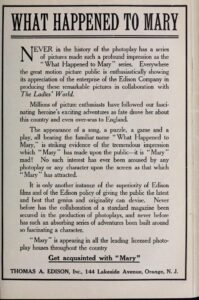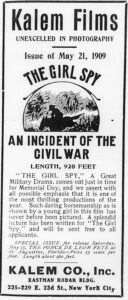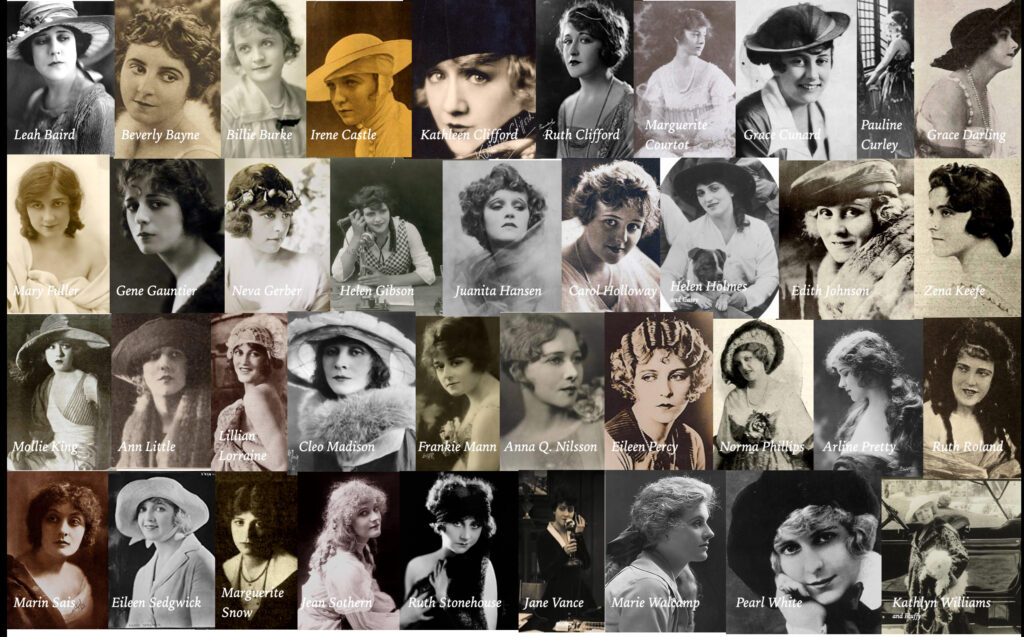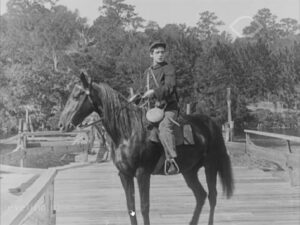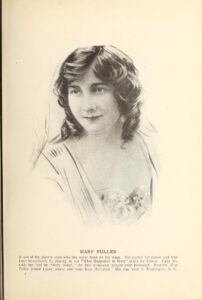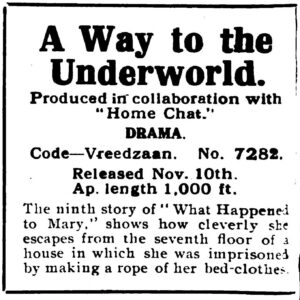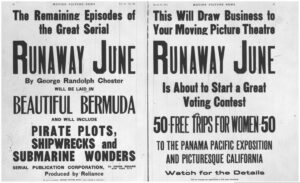Daughters of Mary and Gene: The Two Origins of the Serial Queen Action Heroine
On July 26, 1912, the Edison Company released a film that changed history, reworking the conventions of stage melodrama into an exciting action film that would introduce a new type of female protagonist to the screen. The film was the first episode of What Happened to Mary, the first American film to be released in numbered episodes, and the performer was Mary Fuller, the first serial queen and the woman who laid the groundwork for more famous stars such as Pearl White.
Or so the story goes…
There is another version of the serial queen’s origin story, a version centered on Kalem Company actress Gene Gauntier, who, in 1909, wrote and starred in a short film entitled The Girl Spy: An Incident of the Civil War, the first of six films in which she starred as Nan, an adventurous Confederate woman who regularly dressed as a man to infiltrate Union lines and carry out spectacular acts of sabotage. The Girl Spy films, with their episodic structure and Gauntier’s spectacular stunts, share more with later serials than the relatively slow-paced What Happened to Mary, and suggest that Gauntier, and not Mary Fuller, should be considered the “first” serial queen. However, the Girl Spy films are generally excluded from histories of the serial queen phenomenon. In fact, Gauntier’s influence on the serial queen phenomenon was first written about less than fifteen years ago, when Jane M. Gaines discussed Gauntier in her 2010 article “World Women: Still Circulating Silent Era Prints.” This (re)discovery raises a crucial question: which one of these two origin stories is the correct one?
The answer may well be “both.”
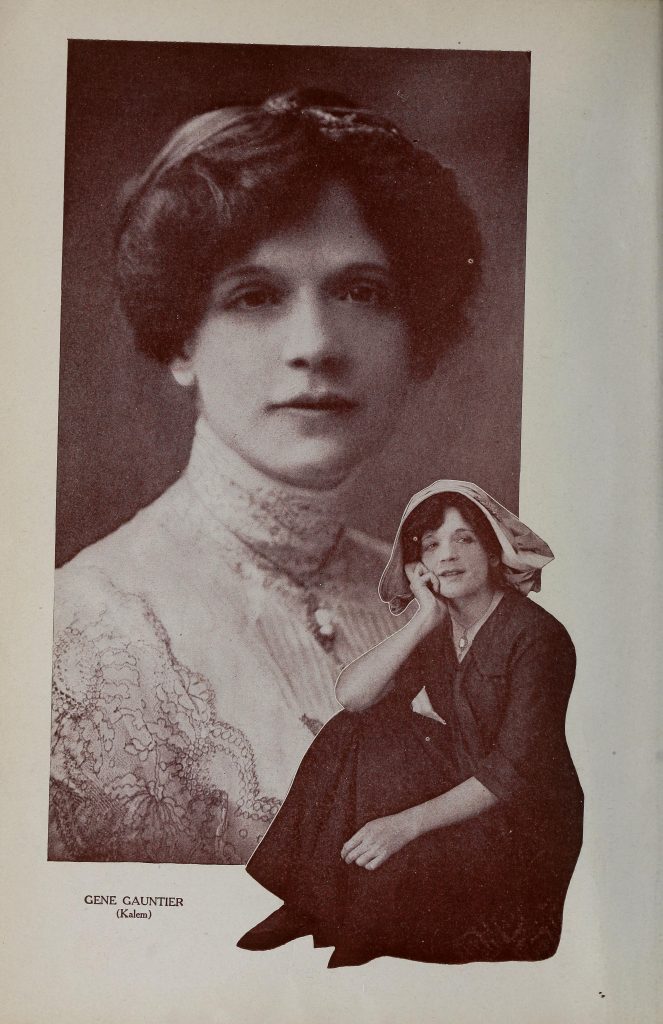
Gene Gauntier in Motion Picture Story Magazine (August 1912): 14.
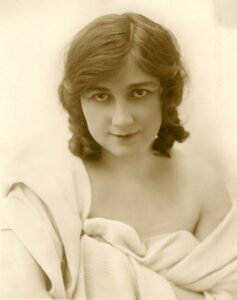
Mary Fuller. Courtesy of the Sayre (J. Willis) Collection of Theatrical Photographs, University Libraries, University of Washington.
Although the films of the serial queens, from today’s perspective, may seem to follow a relatively uniform pattern—following adventurous young women who fought against dastardly villains, often, but not always, in order to claim an inheritance or protect loved ones—for most of their heyday, they actually evolved along two separate, but parallel tracks. One of these tracks emphasized spectacular physical action and thrilling stunts, while the other emphasized the development of melodramatic narrative situations that frequently took precedence over physical action. These two trajectories can be mapped onto the two “founding mothers” of the serial queen phenomenon: Gene Gauntier, action-adventure heroine par excellence, and Mary Fuller, whose serials, though slower-paced and less concerned with spectacular stunts, can nevertheless tell us a great deal about the serial queens. In order to truly understand the serial queen phenomenon, we must not merely replace one currently accepted origin story with another. Instead, we must take the phenomenon’s multiple origin points into account in order to gain a more nuanced understanding of the serial queen, who, of all the female figures recently brought (back) into our film-historical understanding of the silent era, has heretofore remained one of the most elusive.
In most works on the subject, the serial queen has been exemplified by stars such as Pearl White and Helen Holmes, who achieved fame primarily in serials, playing characters who demonstrate large degrees of self-reliance and perform demanding and often dangerous physical feats or stunts over the course of their films, often without the assistance of a stunt double. And there is nothing wrong with this characterization of the serial queen per se. The problem emerges when two or three actresses—namely, Pearl White, Helen Holmes, and sometimes Grace Cunard—are allowed to stand in for a much broader phenomenon.
In my research on the serial queens, I have identified no fewer than thirty-eight actresses in the United States alone whose action-oriented performances in serialized films during the silent era rightly earn them the title of “serial queen.” Furthermore, as a recent edited volume points out, the serial queen phenomenon was by no means limited to the United States (Dahlquist 2014).
This list reminds us that there was no one way to be a serial queen—while all of the serial queens were action heroines in some sense or another, not all of them were as known for death-defying stunts in the same ways that Pearl White or Helen Holmes were. Some, instead, starred in films that emphasized the development of melodramatic narrative situations that frequently took precedence over physical action. It is this variance that needs to be accounted for, and this is the reason that it is so important to have a detailed understanding of the serial queen’s origins.
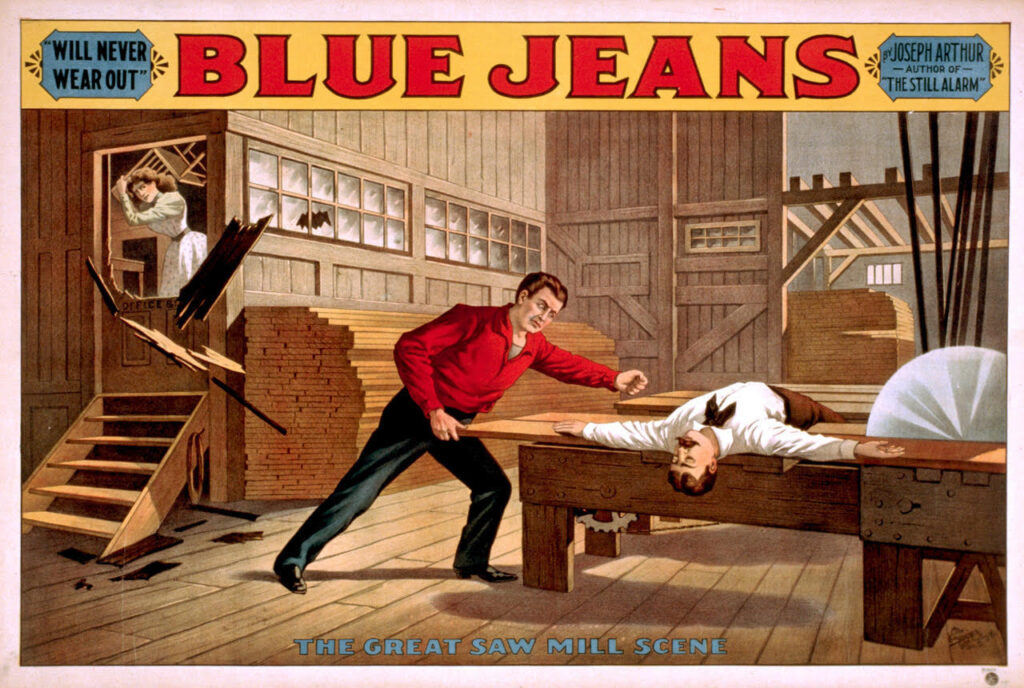
Poster for Joseph Arthur’s 1890 play “Blue Jeans” depicting the famous buzz saw rescue scene.
The roots of the serial queens predate the films of Gene Gauntier and Mary Fuller. In fact, they predate cinema itself. Like so much early narrative cinema, the framework of the serial queen films originated in nineteenth-century stage melodrama, a theatrical form which, as Ben Singer has shown, had its own tradition of daring female heroes who rescued men from buzz saws and onrushing trains just as they would do in the serials (243-244). Furthermore, as Linda Williams points out, these plays centered on “a dialectic of pathos and action” (30), and it is this dialectic that can show us why the serial queen films are such interesting examples of cinematic melodrama—and why they are so unusual.
Singer writes that the serial queens never inspire pathos; their daring heroism is in fact incapable of inspiring pathos because “hardship, abuse, punishment…do not generate pathos if the victim enters into dangers voluntarily, or exhibits sufficient strength, skill, and fortitude of will to allow for the possibility of recuperation, retaliation, or glorification” (56). And while it is not true that the serial queens never inspired pathos, we can use this passage (somewhat against itself) to understand why it is so important when they do. Although pathos and valor do tend to be opposed within a melodramatic narrative, to argue that they can only exist in an inverse relation to one another is to deny the dialectic of pathos and action that Williams sets up. As she points out, these two attributes can interact in such a way that the pathos may “entitle [i.e., enable] action” (32). Importantly, this interaction works differently when the audience’s pathos is inspired by the serial queen’s predicament than it does when it is inspired by the situation that the serial queen is attempting to resolve. This variance is crucial, and the serial queen’s doubled origin may well be the key to understanding it and, in turn, the confounding gender dynamics at the heart of the serial queen phenomenon.
These gender dynamics have been the subject of a great deal of the scholarship on the serial queens. To return once again to Singer, he argues that the serials feature a paradoxical relationship between “power and peril”: although the serial queens were women of action who took control of their own destinies and performed death-defying physical stunts, the serials themselves often seem to punish their stars’ agency by placing them in spectacular danger week after week (221). And, as Shelley Stamp writes in Movie-Struck Girls, the serial queen’s performance of gender relies on a particular form of doubling by which the serial queen effectively plays two different characters, “one conventionally feminine and passive, the other masculine and active” (151). However contradictory it may seem, though, this doubled performance of gender begins to look less puzzling when we consider the fact that the serial queen’s origin is similarly doubled. The two halves of the her gender performance map very neatly onto the performances of the serial queen’s two “founding mothers”: Gene Gauntier’s Girl Spy films, fast-paced and full of spectacular action centered on the serial queen herself, presage the “masculine and active” serial queens while Mary Fuller’s serials typically show the serial queen’s more traditionally feminine side (although Fuller’s performance of gender is by no means conventional).
The differences between Gauntier’s and Fuller’s versions of the serial queen can best be demonstrated through selections from two of their films: Gauntier’s The Girl Spy Before Vicksburg (1911) and Fuller’s “A Way to the Underworld” (1912), the ninth episode of What Happened to Mary. Gauntier’s film, the third Girl Spy film, begins as her character’s father, a beleaguered Confederate general, writes her a letter asking her to once again disguise herself as a man to infiltrate the Union lines. This time, her mission is to sabotage a Union powder transport. She successfully gains the confidence of the Union troops and blows up the powder wagon. This, of course, reveals her as a spy, and she must make a narrow escape from the Union troops, who chase her through the forest, finally losing her trail at a river after she once again proves her physical endurance by hiding underwater for several minutes while the soldiers search for her. After they give up the search, she is able to emerge and return home to her mother—soaking wet and exhausted, but triumphant, and otherwise none the worse for wear.
The first remarkable thing about The Girl Spy Before Vicksburg is the sheer amount of action that it packs into its 14-minute runtime. The film features multiple exciting chase scenes and, of course, the sabotage of the powder wagon. Most importantly, all of this action centers on Nan. She consistently occupies the active position within the narrative, forcing the Union men into the reactive role by remaining one step ahead of them throughout the entire film. This is a characteristic that Nan shares with later serial queens, who consistently exhibit considerable narrative agency, which is to say that they actively initiate events as opposed to simply responding to events initiated by other characters or by “impersonal” causalities such as natural disasters (Bordwell 13).
Another element that the film shares with later serials is the spectacular stunt work. The scene in which Nan blows up the powder wagon is filmed using only two shots: a long take of Nan knocking out the guard, dragging him away, and returning to light the fuse, and another where she sprints away from the powder wagon and ducks out of sight as it explodes, only to immediately pop up after the blast and begin running away from the scene. There are no other edits in the scene—meaning that Gauntier actually was dangerously close to the exploding powder wagon. This was relatively commonplace for Gauntier, who wrote her own screenplays and included daring stunts in nearly every film she made for Kalem. As she writes in her memoirs:
My screen work was all strenuous, horseback riding for hours each day, water scenes in which I committed suicide or floated on spars in shark-infested waters, climbing trees, coming down on ropes from second-story windows, jumping from roofs or rolling down to be caught in blankets, overturning skiffs, paddling canoes, a hundred and one “stunts” thought out to give the action that Kalem films demanded. I was terrified at each daring thing I had to do…but for some inexplicable reason I continued to write them. They never seemed difficult when I was seated before the typewriter. (170)
Importantly, this phenomenon—female stars writing dangerous stunts for themselves to perform—is not unique to Gauntier’s experience and is in fact an integral part of later serial queen films. For example, Helen Holmes once told an interviewer that, “If a photoplay actress wants to achieve real thrills, she must write them into the scenario herself…Men usually won’t provide for a girl things to do that they wouldn’t do themselves” (Duryea 741). What is more, Gauntier shows absolutely no fear in the film’s action sequences, thus inspiring effectively no pathos. This is perhaps the most remarkable aspect of the film, and one of the most obvious differences between her films and the films that Mary Fuller would make just a year later. While Gauntier’s films emphasized action and featured a fearless heroine who runs unhesitatingly into danger, Fuller’s films feature a different kind of action heroine for whom a viewer can feel pathos even as we marvel at her thrilling stunts and escapes.
“A Way to the Underworld” begins with the trial of Richard and Henry Craig, the crooked financiers who have spent the previous eight episodes attempting to swindle Mary, their ward, out of a six million dollar inheritance. They are convicted and sentenced to a long prison term, but even in prison, they continue to scheme. They bribe a prison guard to send a message to Billy Peart, the unscrupulous man who raised the orphaned Mary, instructing him to kidnap Mary and hold her captive until the deadline for claiming her inheritance has passed. Peart visits Mary in New York City and tricks her into a taxicab, where he drugs her, takes her to a run-down building, and imprisons her in a fifth-floor room. After waking up, Mary concocts a plan to escape. She ties together the sheets from her bed and dangles them out the window just as Peart bursts into the room. Hesitatingly, Mary climbs down to the ground and, after pausing briefly to regain her composure, she begins to run with Peart in hot pursuit. Peart is faster, but Mary is more resourceful, taking refuge in a Salvation Army outpost where the missionaries promise to protect her. At this point, the episode ends, reminding us to return to the theater in two weeks to find out “What Happened to Mary” next.
The most obvious point of comparison between What Happened to Mary and The Girl Spy Before Vicksburg is the amount of physical action in the two films. While Gene Gauntier performs several spectacular stunts over the course of her film, in “A Way to the Underworld,” Mary Fuller performs just one: her escape from imprisonment by means of a bedsheet rope. Furthermore, Mary is not as fearless as Gene: she is clearly afraid before attempting to climb down the rope and must shake off fear (and possibly fatigue) after reaching the bottom. There is a visible difference between this version of the serial queen and the one who detonated a wagonload of gunpowder directly behind herself and was up and running before the smoke even cleared. Fuller’s performance is much more likely to move an audience to feel pathos for Mary’s difficult situation than Gauntier’s dauntless performance as Nan.
However, this difference should not be seen as a deficiency. For one thing, although the pathos we feel for Mary does suggest that a rescuer is needed to extricate her from her situation, her resourcefulness allows her to position herself as her own rescuer. Furthermore, the overwhelming focus on spectacular stunts has left scholarship on serial queens with a noticeable blind spot. Yes, the serials of Pearl White and Helen Holmes are fascinating—thrilling pieces of feminist cinema and crucial parts of the history of the action-adventure film. But what do we do with all of the other serial queens—women who made serials in which they were unquestionably the central figures, but which may not have featured as much physical action? It is for the sake of these women’s place in history that I suggest we need to look back to the serial queen’s origins in order to expand our definition of the term, and to realize that while some of their films emphasize physical action and while others emphasize melodramatic situations, they nearly always include both elements. Even the “peerless, fearless” Pearl White generally settled down and married at the end of her serials, although in the case of The House of Hate (1918), her marriage did not mark the end of her adventures as she spends the serial’s final reel as a battlefield nurse during World War I (Weitzel 716). Even serials that have previously been considered too focused on romantic melodrama to be of much interest (for example, Runaway June [1915], starring Norma Phillips and dismissed by Kalton C. Lahue as slow and overly reliant on dialogue titles [33]) appear to have included plenty of action, if its marketing copy can be believed.
In conclusion, by examining the serial queen’s two origin points in conjunction with one another, we stand to gain a more nuanced view of the serial queen and her unusually complex performance of gender. The serial queen’s dual trajectory, launched by the figure’s origin in two different performers, allowed her, as a character type, the ability to operate uncommonly well within a variety of different narrative contexts: some centering primarily on spectacular physical action (the “Daughters of Gene”) and others prioritizing narrative situations (the “Daughters of Mary”). And while the former are far more present in current film historiography than the latter, in order to gain a complete picture of the serial queen phenomenon—one that can escape the binary opposition between “masculine” action and “feminine” sentiment—we will have to take both into account.
A version of this essay was originally presented at the Women and the Silent Screen XI conference in New York in June 2022.
Bibliography
Bordwell, David. “Story Causality and Motivation.” In The Classical Hollywood Cinema: Film Style & Mode of Production to 1960, by Bordwell, Kristen Thompson, and Janet Staiger. New York: Columbia University Press, 1985, 12-23.
Brown, Robert Carlton. What Happened to Mary. New York: Edward J. Close, 1913.
Dahlquist, Marina, ed. Exporting Perilous Pauline. Urbana: University of Illinois Press, 2014.
Duryea, Bryan. “The Necessity of Thrills.” Green Book Magazine 15, no. 4 (April 1916): 741-743.
Enstad, Nan. Ladies of Labor, Girls of Adventure: Working Women, Popular Culture, and Labor Politics at the Turn of the Twentieth Century. New York: Columbia University Press, 1999.
Gaines, Jane M. “World Women: Still Circulating Silent Era Film Prints.” Framework 51, no. 2 (Fall 2010): 283-303.
Gauntier, Gene. “Blazing the Trail: A Fascinating and Authentic History of the Early Motion Pictures [second installment].” Woman’s Home Companion 55, no. 11 (November 1928): 25-26; 166; 168-170.
Lahue, Kalton C. Continued Next Week: A History of the Motion Picture Serial. Norman, OK: University of Oklahoma Press, 1964.
Mahar, Karen Ward. Women Filmmakers in Early Hollywood. Baltimore: Johns Hopkins University Press, 2006.
Singer, Ben. Melodrama and Modernity: Early Sensational Cinema and Its Contexts. New York: Columbia University Press, 2001.
Stamp, Shelley. Movie-Struck Girls: Women and Motion Picture Culture After the Nickelodeon. Princeton: Princeton University Press, 2000.
Stedman, Raymond William. The Serial: Suspense and Drama By Installment. 2nd ed. Norman, OK: University of Oklahoma Press, 1977.
Weitzel, Edward. Review of The House of Hate, chapter 20: “Following Old Glory.” Moving Picture World 37, no. 5 (3 August 1918): 716.
Williams, Linda. Playing the Race Card: Melodramas of Black and White from Uncle Tom to O.J. Simpson. Princeton, NJ: Princeton University Press, 2001.
Citation
Aufmann, Daniel Lawrence. "Daughters of Mary and Gene: The Two Origins of the Serial Queen Action Heroine." In Jane Gaines, Radha Vatsal, and Monica Dall’Asta, eds. Women Film Pioneers Project. New York, NY: Columbia University Libraries, 2022. <https://doi.org/10.7916/s1vb-fs40>

